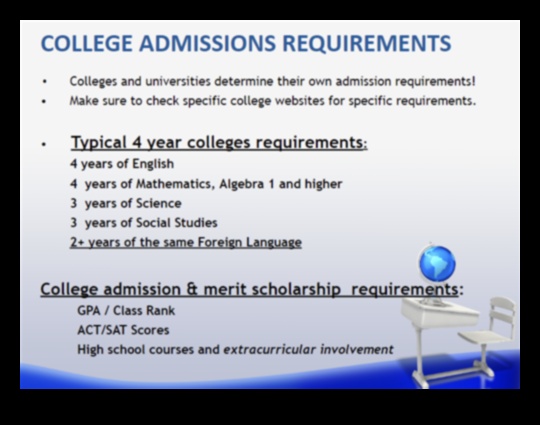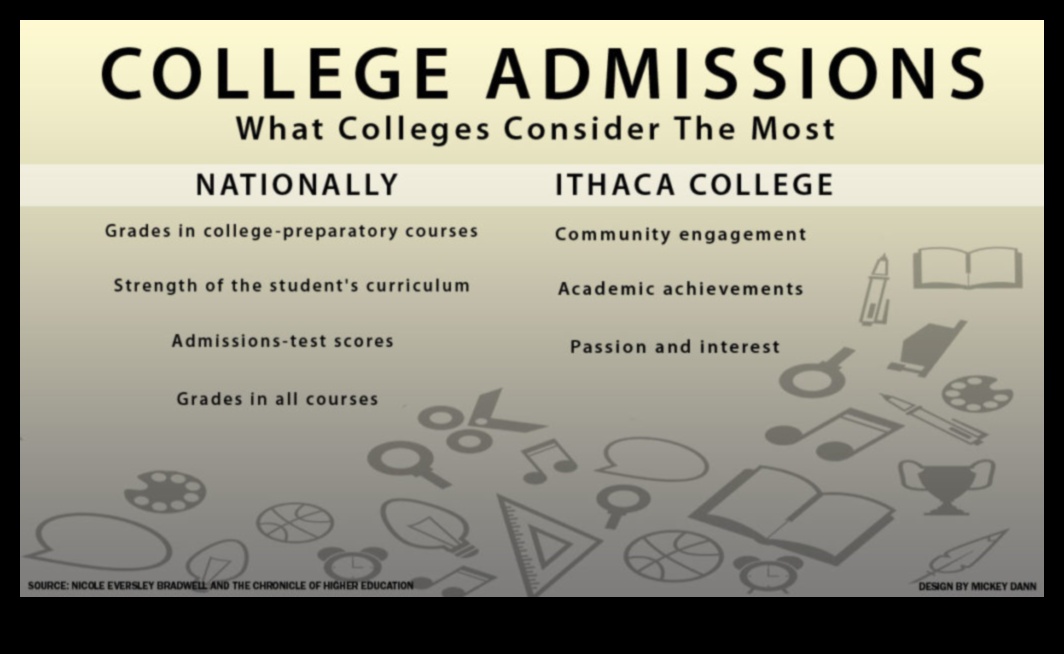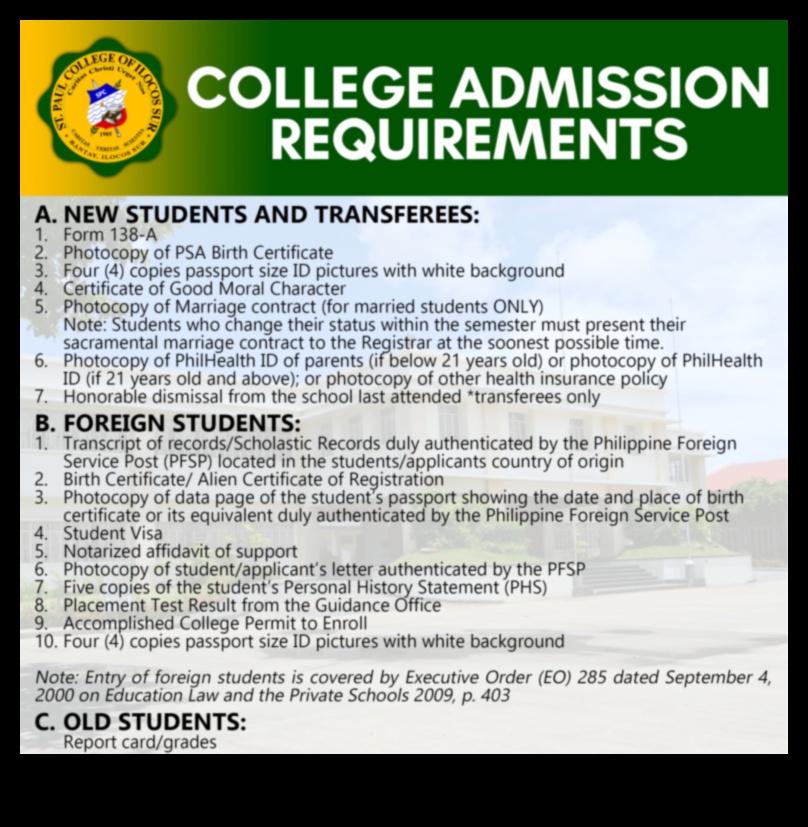
I. Admission Requirements
Admission requirements vary from school to school, but some common requirements include a high school diploma or equivalent, a minimum GPA, standardized test scores, and extracurricular activities.

II. Different Types of Admission Requirements
There are three main types of admission requirements: academic, extracurricular, and personal.
- Academic requirements typically include a minimum GPA, standardized test scores, and transcripts.
- Extracurricular requirements may include participation in sports, clubs, or other activities.
- Personal requirements may include essays, letters of recommendation, and interviews.
III. How to Meet Admission Requirements
In order to meet admission requirements, you will need to start preparing early. This means taking challenging courses in high school, studying for standardized tests, and getting involved in extracurricular activities.
You should also start thinking about your personal statement and letters of recommendation early. These are important parts of your application, and you want to make sure they are well-written and reflect your personality and goals.
IV. When to Apply for Admission
The majority of colleges and universities have rolling admissions, which means that they accept applications on a rolling basis throughout the year. However, some schools have early decision or early action deadlines, which are earlier in the year.
If you are applying to a school with an early decision or early action deadline, you will need to submit your application earlier than you would for a school with rolling admissions.
V. Applying for Admission to Multiple Schools
It is a good idea to apply to multiple schools, even if you have a dream school. This will increase your chances of getting into a school that you are happy with.
When you are applying to multiple schools, it is important to make sure that you are applying to schools that are a good fit for you. You should consider factors such as the size of the school, the location, the academic programs, and the cost.
VI. Financial Aid and Scholarships
The cost of college can be a major factor for students and families. There are a number of financial aid options available, such as scholarships, grants, and loans.
You should start researching financial aid early in the process. This will help you to find the best options for you and your family.
The admission process can be stressful, but it is important to remember that you are not alone. Many students go through the same process.
The admission process typically involves submitting an application, taking standardized tests, and interviewing with admissions officers.
Admission decisions are made on a holistic basis. This means that admissions officers consider a number of factors when making their decisions, including your academic record, extracurricular activities, personal statement, and letters of recommendation.
You will receive an admission decision from each school that you applied to. The decision will be either an acceptance, a deferral, or a rejection.
If you are accepted to a college, you will need to decide whether or not to enroll. This is an important decision, and you should make sure that you are making the right choice for you.
If you decide to enroll, you will need to complete the enrollment process. This typically involves submitting a deposit, registering for classes, and moving into your dorm room.
Here are some frequently asked questions about admission requirements:
- What is the average GPA for admission to college?
- What are the most important factors for college admissions?
- How do I get into a top college?
- What are the best scholarships for college?
- How do I pay for college?
| Topic | Answer |
|---|---|
| Admission Requirements | The requirements for admission to a college or university vary depending on the school. Some of the most common requirements include a high school diploma or equivalent, a minimum GPA, test scores, and extracurricular activities. |
| College Admissions | The college admissions process is complex and competitive. It typically involves submitting an application, transcripts, test scores, and letters of recommendation. |
| University Admissions | The university admissions process is similar to the college admissions process, but it may be more competitive. Universities typically have higher acceptance rates than colleges. |
| High School Requirements | Students who want to attend college or university should take rigorous courses in high school. These courses will help them prepare for the college admissions process and for college-level coursework. |
| College Application | The college application is an important part of the admissions process. It is your chance to show the admissions committee who you are and why you would be a good fit for their school. |
II. Different Types of Admission Requirements
There are a variety of different types of admission requirements that colleges and universities may consider when making admissions decisions. These requirements can include:
- Grade point average (GPA)
- Test scores
- Extracurricular activities
- Essays
- Letters of recommendation
- Personal interviews
The specific requirements that a college or university will consider will vary depending on the school’s individual admissions criteria. However, all colleges and universities are looking for students who are academically qualified, have a strong work ethic, and are involved in extracurricular activities.

II. Different Types of Admission Requirements
There are a variety of different types of admission requirements that colleges and universities may consider when making admissions decisions. These requirements can include:
- GPA
- Test scores
- Extracurricular activities
- Essays
- Letters of recommendation
- Interviews
The weight that each of these factors is given in the admissions process will vary from school to school. Some schools may place a greater emphasis on GPA and test scores, while others may be more interested in extracurricular activities and essays. It is important to research the admissions requirements of the schools you are interested in so that you can make sure you are meeting their expectations.
In addition to the academic and extracurricular requirements listed above, some schools may also have specific requirements for students from certain backgrounds or with certain interests. For example, some schools may have a diversity requirement or a STEM requirement. It is important to be aware of these requirements when you are applying to schools so that you can make sure you are meeting them.
Admission Requirements
Admission requirements vary from school to school, but there are some general requirements that most colleges and universities look for. These include:
- GPA: Most colleges and universities require a minimum GPA of 3.0 or higher. However, some schools may have higher or lower GPA requirements, depending on the competitiveness of their admissions pool.
- Test scores: Many colleges and universities require applicants to submit standardized test scores, such as the SAT or ACT. The minimum test score requirements vary from school to school, but a score of 1400 on the SAT or 25 on the ACT is generally considered to be competitive.
- Extracurricular activities: Colleges and universities look for students who are involved in extracurricular activities. These activities can show that you are a well-rounded individual who is interested in more than just academics.
- Essays: Many colleges and universities require applicants to submit an essay or personal statement as part of their application. This essay is an opportunity for you to share your story and tell the admissions committee why you want to attend their school.
In addition to these general requirements, some colleges and universities may have additional requirements, such as specific coursework or letters of recommendation. It is important to research the admissions requirements of the schools you are interested in so that you can make sure you meet all of the requirements.
V. Applying for Admission to Multiple Schools
When applying to multiple schools, it is important to be strategic about your choices. You should consider factors such as your academic and extracurricular qualifications, the cost of attendance, and the location of the school. It is also important to make sure that you apply to a variety of schools, so that you have a good chance of being accepted to at least one of them.
Here are some tips for applying to multiple schools:
- Start early. The admissions process can take a long time, so it is important to start your research and applications early.
- Create a list of schools that you are interested in. When making your list, consider factors such as your academic and extracurricular qualifications, the cost of attendance, and the location of the school.
- Write strong personal statements and essays. Your personal statements and essays are an opportunity to show admissions officers who you are and why you are a good fit for their school.
- Get good grades and test scores. Your grades and test scores are important factors in the admissions process. Make sure that you are doing your best in school and studying hard for your standardized tests.
- Get involved in extracurricular activities. Extracurricular activities can show admissions officers that you are a well-rounded individual with interests outside of academics.
- Ask for letters of recommendation. Letters of recommendation from teachers, coaches, or other mentors can help to boost your application.
- Submit your applications on time. Most schools have deadlines for submitting applications. Make sure that you submit your applications on time to avoid being penalized.
By following these tips, you can increase your chances of being accepted to multiple schools.
II. Different Types of Admission Requirements
There are a number of different types of admission requirements that colleges and universities may consider when making admissions decisions. These include:
- Academic GPA
- Test scores (SAT/ACT)
- Extracurricular activities
- Letters of recommendation
- Personal statements
The weight that each of these factors is given in the admissions process will vary from school to school. Some schools may place a greater emphasis on academic GPA, while others may be more interested in extracurricular activities or letters of recommendation. It is important to research the admissions requirements of the schools you are interested in so that you can make sure you are prepared to meet their standards.
In addition to the academic and extracurricular requirements listed above, some schools may also have specific requirements for students from certain backgrounds or with certain interests. For example, some schools may have a minimum GPA requirement for students from low-income families, or they may offer scholarships to students who are interested in pursuing a particular field of study. It is important to be aware of these types of requirements when you are applying to college so that you can make sure you are eligible for any available scholarships or programs.
VII. The Admission Process
The admission process can vary from school to school, but there are some general steps that most schools follow.
- Students submit their application materials, which typically include a transcript, test scores, and a personal statement.
- Schools review the applications and select a pool of applicants to interview.
- Students who are invited to interview will meet with admissions representatives to discuss their qualifications and interests.
- Schools make admission decisions and notify students of their status.
The admission process can be competitive, so it’s important to start early and prepare your application materials carefully.
For more information on the admission process, you can visit the websites of the schools you’re interested in. You can also contact the admissions office for more information.
Admission Decisions
Admission decisions are made by the admissions committee at each school or university. The committee will review your application materials, including your academic record, test scores, extracurricular activities, and personal statement, and make a decision about whether to admit you to the school.
The admissions process can be competitive, so it’s important to make sure that your application is as strong as possible. This means that you should have a high GPA, good test scores, and a strong extracurricular record. You should also write a personal statement that is well-written and that highlights your strengths and why you would be a good fit for the school.
Admission decisions are usually made in the spring, and you will be notified by the school if you have been accepted. If you are accepted, you will be given a letter of acceptance and information about how to enroll in the school.
If you are not accepted to the school of your choice, you may be eligible for deferred admission or waitlist placement. With deferred admission, you will be considered for admission again the following year. With waitlist placement, you will be placed on a list of students who will be admitted if there are any spots available after all of the accepted students have enrolled.
IX. Enrolling in College
Once you have been accepted to college, the next step is to enroll. This process typically involves submitting a deposit to the college, providing your official transcripts, and completing any other required paperwork. You may also need to attend a new student orientation session.
Enrolling in college is an exciting time, but it can also be a bit overwhelming. Here are a few tips to help you through the process:
- Start early. The sooner you start the enrollment process, the more time you will have to get everything done.
- Read the instructions carefully. Make sure you understand all of the requirements and deadlines.
- Ask for help if you need it. There are many people available to help you with the enrollment process, including your guidance counselor, admissions counselor, and financial aid office.
- Be prepared to pay the deposit. Most colleges require a deposit to hold your spot in the class.
- Stay organized. Keep track of all of your paperwork and deadlines.
By following these tips, you can make the enrollment process as smooth and stress-free as possible.
X. FAQ
Q: What are the different types of admission requirements?
A: There are a variety of different types of admission requirements that colleges and universities may consider when making admissions decisions. These can include:
* GPA requirements
* Test scores
* Extracurricular activities
* Letters of recommendation
* Personal statements
* Interviews
Q: How can I meet admission requirements?
A: There are a number of things you can do to improve your chances of meeting admission requirements. These include:
* Maintaining a high GPA
* Studying for and taking standardized tests
* Participating in extracurricular activities
* Seeking out strong letters of recommendation
* Writing a strong personal statement
* Preparing for and practicing for interviews
Q: What happens if I don’t meet admission requirements?
A: If you don’t meet admission requirements, there are still a number of options available to you. You may be able to appeal the decision, apply to a different school, or take a gap year to improve your academic standing.